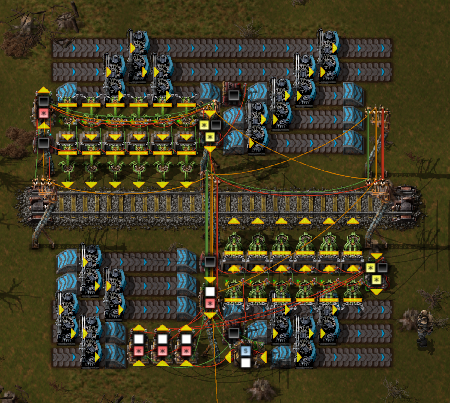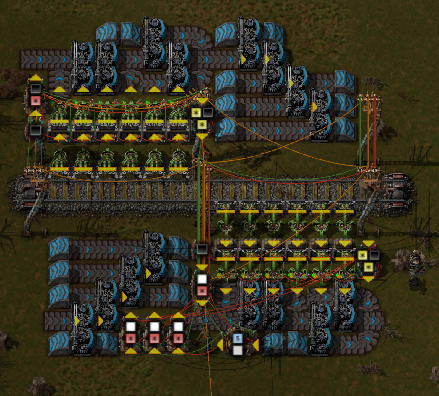
Loads two railcars from five lanes on each side. The design is tileable so you can build massive railcar loading stations.
By default every tile will average their input among available chests. The chests will fill evenly which means you can load trains far more efficiently. This allows for much higher throughput at a single loading station.
If you input the [S] virtual item (at any value except zero) into any power pole, then the ARLTs will split the loading averages so you can load a different item on each side.
Autonomous Railcar Unloader Tile

Unloads two railcars into five lanes on each side; each railcar will saturate a single lane. The design is tileable so you can build massive railcar unloading stations.
By default every tile will average their output among available chests. The chests will empty evenly so you can unload trains far more efficiently. This allows for much higher throughput at a single unloading station.
If you input the [S] virtual item (at any value except zero) into any power pole, then the ARUTs will split the unloading averages so you can unload a different item on each side.
---[[[]]]---
I built the ARUT first. It was the harder of the two to assemble even though it uses less pieces! The spaghetti belt arrangement will keep a single belt constantly saturated even when inserters are waiting for an averaged load. A typical 5 lane balancer would not fit into a 6x14 area... But if the lane was already saturated it becomes a simple matter of offloading the contents and keeping the output lane empty. This is the reason why the fourth lane from the center on each side does not connect to the adjacent lane in the next tile - each half tile can saturate a lane all by itself.
After that, it was a simple matter of swapping the positions and activation values of each inserter. The ARLT doesn't need some fancy output arrangement, so shoving as much as possible through the input lane will of course suffice. It can't fully saturate every single inserter with this design, but that doesn't matter since the lag time between trains leaving and entering the station should keep every chest buffered. The ARLT did have a slight hiccup though; dividing ■ by ■ equals 1, so the inserter condition would always evaluate to false. I placed two constant combinators outputting ■ -1 to patch the problem.
I haven't actually tested the arrangement of smart splitters in each design, so I can't guarantee they'll saturate all ten lanes properly. If anyone has any problems with that please let me know.


